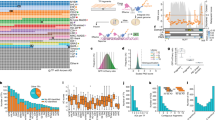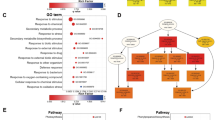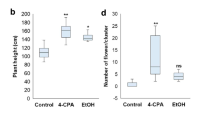Abstract
Messenger RNA (mRNA) turnover in eukaryotic cells begins with shortening of the poly (A) tail at the 3′ end, a process called deadenylation. In yeast, the deadenylation reaction is predominantly mediated by CCR4 and CCR4-associated factor 1 (CAF1), two components of the well-characterised protein complex named CCR4-NOT. We report here that AtCAF1a and AtCAF1b, putative Arabidopsis homologs of the yeast CAF1 gene, partially complement the growth defect of the yeast caf1 mutant in the presence of caffeine or at high temperatures. The expression of AtCAF1a and AtCAF1b is induced by multiple stress-related hormones and stimuli. Both AtCAF1a and AtCAF1b show deadenylation activity in vitro and point mutations in the predicted active sites disrupt this activity. T-DNA insertion mutants disrupting the expression of AtCAF1a and/or AtCAF1b are defective in deadenylation of stress-related mRNAs, indicating that the two AtCAF1 proteins are involved in regulated mRNA deadenylation in vivo. Interestingly, the single and double mutants of AtCAF1a and AtCAF1b show reduced expression of pathogenesis-related (PR) genes PR1 and PR2 and are more susceptible to Pseudomonas syringae pv tomato DC3000 (Pst DC3000) infection, whereas transgenic plants over-expressing AtCAF1a show elevated expression of PR1 and PR2 and increased resistance to the same pathogen. Our results suggest roles of the AtCAF1 proteins in regulated mRNA deadenylation and defence responses to pathogen infections.
Similar content being viewed by others
Log in or create a free account to read this content
Gain free access to this article, as well as selected content from this journal and more on nature.com
or
References
Tucker M, Parker R . Mechanisms and control of mRNA decapping in Saccharomyces cerevisiae. Annu Rev Biochem 2000; 69:571–595.
Parker R, Song H . The enzymes and control of eukaryotic mRNA turnover. Nat Struct Mol Biol 2004; 11:121–127.
Cao D, Parker R . Computational modeling of eukaryotic mRNA turnover. RNA 2001; 7:1192–1212.
Denis CL, Chen J . The CCR4-NOT complex plays diverse roles in mRNA metabolism. Prog Nucleic Acid Res Mol Biol 2003; 73:221–250.
Brown CE, Sachs AB . Poly (A) tail length control in Saccharomyces cerevisiae occurs by message-specific deadenylation. Mol Cell Biol 1998; 18:6548–6559.
Hammet A, Pike BL, Heierhorst J . Posttranscriptional regulation of the RAD5 DNA repair gene by the Dun1 kinase and the Pan2-Pan3 poly (A)-nuclease complex contributes to survival of replication blocks. J Biol Chem 2002; 277:22469–22474.
Gao M, Fritz DT, Ford LP, Wilusz J . Interaction between a poly (A)-specific ribonuclease and the 5′ cap influences mRNA deadenylation rates in vitro. Mol Cell 2000; 5:479–488.
Reverdatto SV, Dutko JA, Chekanova JA, Hamilton DA, Belostotsky DA . mRNA deadenylation by PARN is essential for embryogenesis in higher plants. RNA 2004; 10:1200–1214.
Nishimura N, Kitahata N, Seki M, et al. Analysis of ABA hypersensitive germination2 revealed the pivotal functions of PARN in stress response in Arabidopsis. Plant J 2005; 44:972–984.
Collart MA, Timmers HT . The eukaryotic Ccr4-not complex: a regulatory platform integrating mRNA metabolism with cellular signaling pathways? Prog Nucleic Acid Res Mol Biol 2004; 77:289–322.
Liu HY, Badarinarayana V, Audino DC, et al. The NOT proteins are part of the CCR4 transcriptional complex and affect gene expression both positively and negatively. EMBO J 1998; 17:1096–1106.
Bai Y, Salvadore C, Chiang YC, et al. The CCR4 and CAF1 proteins of the CCR4-NOT complex are physically and functionally separated from NOT2, NOT4, and NOT5. Mol Cell Biol 1999; 19:6642–6651.
Chen J, Rappsilber J, Chiang YC, Russell P, Mann M, Denis CL . Purification and characterization of the 1.0 MDa CCR4-NOT complex identifies two novel components of the complex. J Mol Biol 2001; 314:683–694.
Tucker M, Valencia-Sanchez MA, Staples RR, Chen J, Denis CL, Parker R . The transcription factor associated Ccr4 and Caf1 proteins are components of the major cytoplasmic mRNA deadenylase in Saccharomyces cerevisiae. Cell 2001; 104:377–386.
Chen J, Chiang YC, Denis CL . CCR4, a 3′-5′ poly (A) RNA and ssDNA exonuclease, is the catalytic component of the cytoplasmic deadenylase. EMBO J 2002; 21:1414–1426.
Tucker M, Staples RR, Valencia-Sanchez MA, Muhlrad D, Parker R . Ccr4p is the catalytic subunit of a Ccr4/Pop2p/Notp mRNA deadenylase complex in Saccharomyces cerevisiae. EMBO J 2002; 21:1427–1436.
Daugeron MC, Mauxion F, Séraphin B . The yeast POP2 gene encodes a nuclease involved in mRNA deadenylation. Nucleic Acids Res 2001; 29:2448–2455.
Zuo Y, Deutscher MP . Exoribonuclease superfamilies: structural analysis and phylogenetic distribution. Nucleic Acids Res 2001; 29:1017–1026.
Thore S, Mauxion F, Séraphin B, Suck D . X-ray structure and activity of the yeast Pop2 protein: a nuclease subunit of the mRNA deadenylase complex. EMBO Rep 2003; 4:1150–1155.
Viswanathan P, Ohn T, Chiang YC, Chen J, Denis CL . Mouse CAF1 can function as a processive deadenylase/3′-5′ exonuclease in vitro but in yeast the deadenylase function of CAF1 is not required for mRNA poly(A) removal. J Biol Chem 2004; 279:23988–23995.
Ohn T, Chiang YC, Lee DJ, Yao G, Zhang CX, Denis CL . CAF1 plays an important role in mRNA deadenylation separate from its contact to CCR4. Nucleic Acids Res 2007; 35:3002–3015.
Sakai A, Chibazakura T, Shimizu Y, Hishinuma F . Molecular analysis of POP2 gene, a gene required for glucose-derepression of gene expression in Saccharomyces cerevisiae. Nucleic Acids Res 1992; 20:6227–6233.
Hata H, Mitsui H, Liu H, et al. Dhh1p, a putative RNA helicase, associates with the general transcription factors Pop2p and Ccr4p from Saccharomyces cerevisiae. Genetics 1998; 148:571–579.
Berthet C, Morera AM, Asensio MJ, et al. CCR4-associated factor CAF1 is an essential factor for spermatogenesis. Mol Cell Biol 2004; 24:5808–5820.
Molin L, Puisieux A . C. elegans homologue of the Caf1 gene, which encodes a subunit of the CCR4-NOT complex, is essential for embryonic and larval development and for meiotic progression. Gene 2005; 358:73–81.
Sarowar S, Oh HW, Cho HS, et al. Capsicum annuum CCR4-associated factor CaCAF1 is necessary for plant development and defence response. Plant J 2007; 51:792–802.
Walley JE, Coughlan S, Hudson ME, et al. Mechanical stress induces biotic and abiotic stress responses via a novel cis-element. PLoS Genet 2007; 3:1800–1812.
Zheng W, Zhai Q, Sun J, et al. Bestatin, an inhibitor of aminopeptidases, provides a chemical genetics approach to dissect jasmonate signaling in Arabidopsis. Plant Physiol 2006; 141:1400–1413.
Berger S, Bell E, Mullet JE . Two methyl jasmonate-insensitive mutants show altered expression of AtVsp in response to methyl jasmonate and wounding. Plant Physiol 1996; 111:525–531.
Samac DA, Hironaka CM, Yallaly PE, Shah DM . Isolation and characterization of the genes encoding basic and acidic chitinase in Arabidopsis thaliana. Plant Physiol 1990; 93:907–914.
Lorenzo O, Piqueras R, Sánchez-Serrano JJ, Solano R . ETHYLENE RESPONSE FACTOR1 integrates signals from ethylene and jasmonate pathways in plant defense. Plant Cell 2003; 15:165–178.
Bell E, Creelman RA, Mullet JE . A chloroplast lipoxygenase is required for wound-induced jasmonic acid accumulation in Arabidopsis. Proc Natl Acad Sci USA 1995; 92:8675–8679.
Dharmasiri N, Dharmasiri S, Estelle M . The F-box protein TIR1 is an auxin receptor. Nature 2005; 435:441–445.
Kepinski S, Leyser O . The Arabidopsis F-box protein TIR1 is an auxin receptor. Nature 2005; 435:446–451.
Hooker TS, Lam P, Zheng H, Kunst L . A core subunit of the RNA-processing/degrading exosome specifically influences cuticular wax biosynthesis in Arabidopsis. Plant Cell 2007; 19:904–913.
Bechtold N, Pelletier G . In planta Agrobacterium-mediated transformation of adult Arabidopsis thaliana plants by vacuum infiltration. Methods Mol Biol 1998; 82:259–266.
Jefferson RA . Assaying chimeric genes in plants: The GUS gene fusion system. Plant Mol Bio Rep 1987; 5:387–405.
Sallés FJ, Richards WG, Strickland S . Assaying the polyadenylation state of mRNAs. Methods 1999; 17:38–45.
Acknowledgements
We thank Clyde L Denis (University of New Hampshire, USA) for providing the yeast strains, Jianmin Zhou (National Institute of Biological Sciences, China) for providing the bacterial strain Pseudomonas syringae pv tomato DC3000, and Akira Sakai (Mitsubishi Kasei Institute of Life Sciences, Japan) for his insightful comments on the yeast complementation assays. We are grateful to the anonymous reviewers for their valuable suggestions for this manuscript. This work was supported by grants from the National Natural Science Foundation of China (30425033, 30530440), the Ministry of Science and Technology of China (2006CB102004, 2006AA10A116) and the Chinese Academy of Sciences (KSCX2-YW-N-045).
Author information
Authors and Affiliations
Corresponding author
Supplementary information
Supplementary information, Figure S1
Comparison of the amino acid sequences of AtCAF1 and CAF1 proteins from Capsicum annuum (Ca), C. elegans (Ce), Drosophila melanogaster (Dm), Homo sapiens (Hs), Mus musculus (Mm), and S. cerevisiae (Sc) (only the RNase D domain is shown). (PDF 345 kb)
Supplementary information, Table S1
Oligonucleotides used in this study (PDF 50 kb)
Rights and permissions
About this article
Cite this article
Liang, W., Li, C., Liu, F. et al. The Arabidopsis homologs of CCR4-associated factor 1 show mRNA deadenylation activity and play a role in plant defence responses. Cell Res 19, 307–316 (2009). https://doi.org/10.1038/cr.2008.317
Received:
Revised:
Accepted:
Published:
Issue date:
DOI: https://doi.org/10.1038/cr.2008.317
Keywords
This article is cited by
-
A plant tethering system for the functional study of protein-RNA interactions in vivo
Plant Methods (2022)
-
A CCR4-associated factor 1, OsCAF1B, confers tolerance of low-temperature stress to rice seedlings
Plant Molecular Biology (2021)
-
Investigation of the effects of P1 on HC-pro-mediated gene silencing suppression through genetics and omics approaches
Botanical Studies (2020)
-
Transcriptome Profiling Through Next-Generation Sequencing in Sugarcane Under Moisture-Deficit Stress Condition
Sugar Tech (2020)
-
Cauliflower mosaic virus transactivator protein (TAV) can suppress nonsense-mediated decay by targeting VARICOSE, a scaffold protein of the decapping complex
Scientific Reports (2019)



